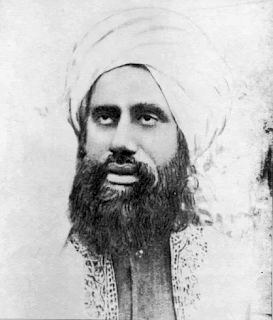 March 23 is an important date in the modern history of
spiritual Islam. It was on this Day in 1889 that the the Jamaat-e- Ahmadiyya was established by the Promised Massih Hadhrat
Mirza Ghulam Ahmad (as) of Qadian. [Inset: a photo from the 2005 Jalsa Salana at Qadian, which the present writer attended]. He initiated the Bai’at Programme through which devout Muslims could express their
allegiance to the Divine appointee. In a special speech to mark the occasion on
Saturday, 23 March 2013 the Chosen Messenger of our times, the Khalifatullah Hadhrat
Munir Ahmad Azim Sahib (atba) of Mauritius spoke at length about the
sacred, foundational prophecies that undergird the belief about the coming of Divine
Messengers/Massihs’/Mahdis’ in the
Latter Days of Islam. The speech beautifully captures the essence of Divine
prophecies foretold in the sacred writings of Muslims, Christians and the seers
of other religious. It demonstrates how these prophecies have been fulfilled in
the times of the Promised Massih (as) and also reflects on their
contemporary significance. The spiritual outlook regarding the continuity of Divine revelations and the appearance of Divine
Messengers in future, who will speak with
the Holy Spirit, as emerging from the writings of the Promised Massih (as) and as discussed in the speech must
be of special interest to devout Ahmadis.
March 23 is an important date in the modern history of
spiritual Islam. It was on this Day in 1889 that the the Jamaat-e- Ahmadiyya was established by the Promised Massih Hadhrat
Mirza Ghulam Ahmad (as) of Qadian. [Inset: a photo from the 2005 Jalsa Salana at Qadian, which the present writer attended]. He initiated the Bai’at Programme through which devout Muslims could express their
allegiance to the Divine appointee. In a special speech to mark the occasion on
Saturday, 23 March 2013 the Chosen Messenger of our times, the Khalifatullah Hadhrat
Munir Ahmad Azim Sahib (atba) of Mauritius spoke at length about the
sacred, foundational prophecies that undergird the belief about the coming of Divine
Messengers/Massihs’/Mahdis’ in the
Latter Days of Islam. The speech beautifully captures the essence of Divine
prophecies foretold in the sacred writings of Muslims, Christians and the seers
of other religious. It demonstrates how these prophecies have been fulfilled in
the times of the Promised Massih (as) and also reflects on their
contemporary significance. The spiritual outlook regarding the continuity of Divine revelations and the appearance of Divine
Messengers in future, who will speak with
the Holy Spirit, as emerging from the writings of the Promised Massih (as) and as discussed in the speech must
be of special interest to devout Ahmadis.
Read the
Extracts from the Speech:
Today 23 March 2013 establishes 124 years since an event took place in the once unknown small village – Qadian – situated in the province of Punjab in India. It was an event destined to change the course of history. In Islamic literature, the Quran predicts a thousand years during which Islam will suffer an extraordinary decline.
“He regulates His command from the heaven to the earth; then shall it ascend to Him in a day the measure of which is a thousand years of what you count.” (As-Sajdah 32: 6).
The Holy Prophet (peace be upon him) has predicted that this decline will not begin until three hundred years after his advent: “The best century is the one in which I live, then the second and the third will be good, afterwards lies will spread, truth shall disappear; cruelty, excesses, differences and divergences shall appear”. (Miskat, Bukhari & Tirmidhi).
